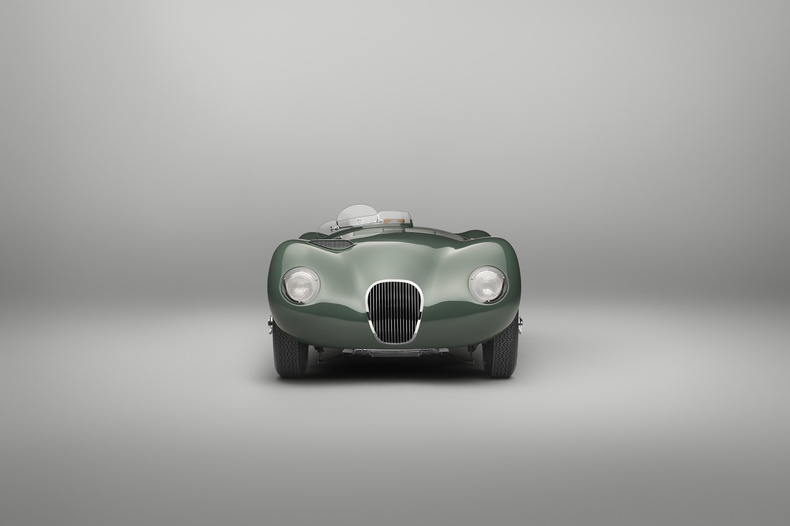Jaguar brings classic C-type Continuation back to life

Jaguar Classic is bringing a limited run of new C-type Continuations to life in celebration of the iconic model 's motorsport heritage, 70 years after it first raced to victory at the Le Mans 24 Hours.
The landmark vehicle made its public debut at the prestigious Concours of Elegance at Hampton Court Palace on Friday 3 September.
The C-type Continuation will be hand built at Jaguar Classic Works in Coventry, to the specification of the 1953 'works ' C-types that dominated that year 's Le Mans 24 Hours, scoring the C-type 's second Le Mans win and continuing a run of motorsport success for the company.
The team at Jaguar Classic has painstakingly researched the C-type 's history for the Continuation 's exacting specification, bringing Jaguar 's heritage to life through modern technology and engineering expertise.
This includes the use of the same authentic techniques and build methods as in period.
Dan Pink, director, Jaguar Classic, said: “The C-type is one of the most iconic cars in Jaguar 's illustrious racing history, driven by some of the most-admired drivers in history.
“The C-type Continuation keeps Malcolm Sayers ' iconic and advanced design alive thanks to the first application of 3D CAD drawings by Jaguar Classic, marrying design and motorsport heritage with the very latest engineering tools. ”
The vision of Malcolm Sayer, legendary Jaguar Cars designer, aerodynamicist, engineering prodigy and artist, the C-type originally raced from 1951, and secured victory at Le Mans first time out. Its pioneering slippery shape helped the winning drivers of Peter Walker and Peter Whitehead achieve a record breaking average speed of 93.495 miles per hour.
However, the C-type is particularly notable for the first use of disc brakes from 1952. Developed with Dunlop, combined with upgrades to the engine and suspension, they contributed to C-types dominating the 1953 Le Mans 24 Hour, with a first and second place finish, and a record smashing average speed of 105.841 miles per hour.
This was the first time the race had been completed at over 100 mph average.
The original C-type was famed for its fluid and aerodynamic shape, which was designed by Malcolm Sayer, who was recruited by William Lyons in 1950.
Originally dubbed the XK120C and using that iconic vehicle as its base, the C-type would go on to become one of the most important cars in Jaguar 's racing history.
The C-type used the XK120 's engine, transmission and suspension, while Malcolm Sayer penned its smooth and aerodynamic body using his established background in engineering and aerodynamics from the aerospace industry to maximum advantage. Using complicated mathematic formulae to create three-dimensional curves, Sayer applied his unique ability for artistic skill and aerodynamic expertise to produce the C-type. He made its exotic design come alive through advanced calculations.
Designed, engineered and built in just six months, 12 Jaguar personnel arrived with a trio of C-types at the 1951 Le Mans 24 Hours, having driven from the UK in the competing cars.
In its debut year, in 1951, the C-type won the Le Mans 24 Hours, the first of many Jaguar motorsport victories.
Three cars entered, driven by Stirling Moss and Jack Fairman, Leslie Johnson and Clemente Biondetti and the partnership that would go on to win the race: Peter Walker and Peter Whitehead.
Designed with a drilled tubular chassis frame to prioritise weight saving, the C-type represented key improvements on the XK120 all-round.
Developments over time, along with the first application of disc brakes, included the use of 16-inch 60-spoke wire wheels on 1953 works cars to improve cooling for the brakes.
Meanwhile, innovations such as using a Panhard rod for the rear suspension also improved the vehicle, to hone the C-type into its ultimate 1953 configuration.
At the 1953 Le Mans 24 Hours, the updated C-type broke the 100mph 24-hour average speed record at 105.85mph, representing a significant step forwards from the 93.49mph 24-hour record-breaking average speed the C-type set in 1951.
Contributing to this success was the use of three Weber 40DCO3 carburettors that gave a boost to the 3.4-litre straight-six engine 's horsepower from 200bhp to 220bhp. The extra power, combined with the first fitment of disc brakes and the lightweight body all contributed to the Jaguar 's second Le Mans triumph.
A tell-tale clue that identifies 1953 specification models is the bonnet vent that directs air straight into the carburettors at the top of the engine bay, with the assistance of an intricately designed air box - just one of several unique touches on the 1953 car that will be shared with all C-type Continuations.
Driven by Duncan Hamilton and Tony Rolt, the winning car in 1953 led to much wider adoption of disc brakes both for race use and on the road. Jaguar 's engineering innovations would set the tone for the whole industry, using its motorsport know-how to improve driving experiences for all.
